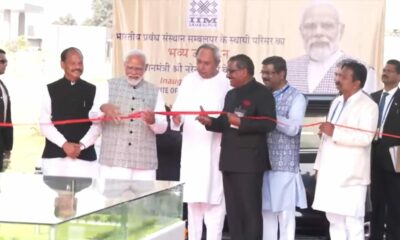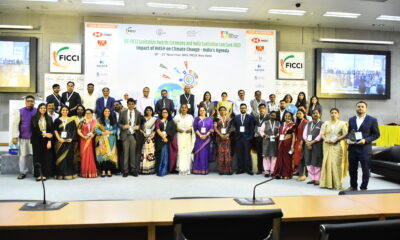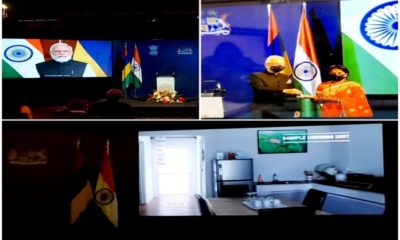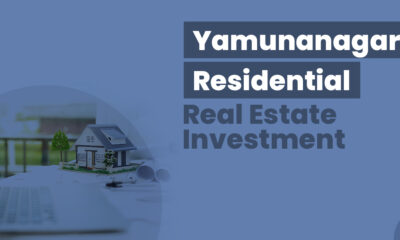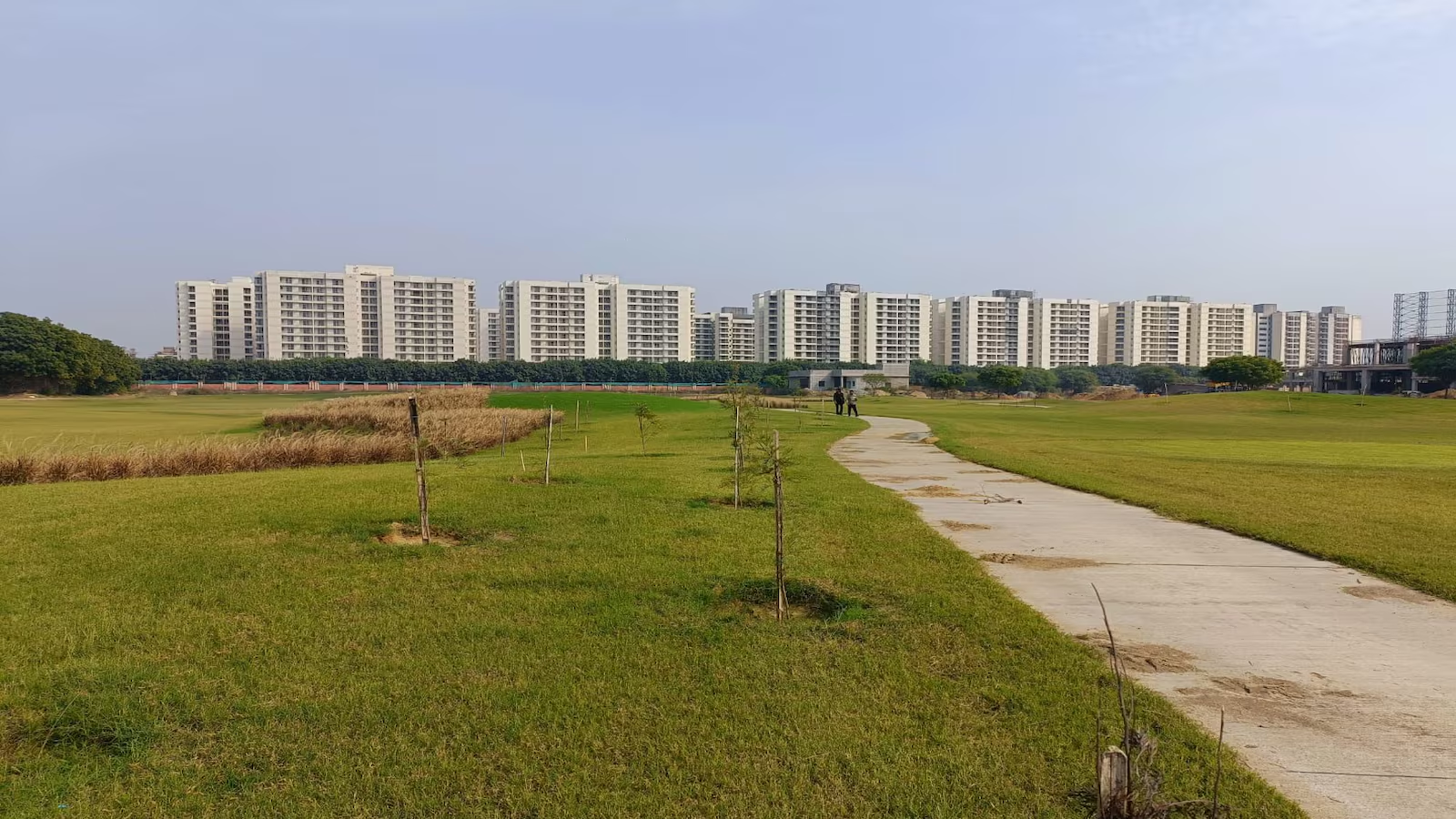Top Stories
PM Modi’s three-pronged initiative to transform urban living




Marking a water shed initiative for the urban development and revolution in the country, Prime Minister Narendra Modi last month launched the three most ambitious schemes of the NDA Government which have the potential of transforming the way we live in India and catapulting the country to the global map as the most rapidly developing nation.
The much-awaited launch on June 25 of the three monumental schemes-Smart Cities Mission, Atal Mission for Rejuvenation and Urban Transformation (AM RUT) and’ Housing for All by 2022′(now renamed Pradhan Mantri Awas Yojana)-that will cost the Government a total of about Rs 4 lakh crore is bound to impact the life of every citizen in the country and prove immensely beneficial to every stakeholder in the real estate industry.
While 500 cities will be developed under the AMRUT scheme, 100 smart cities will come up in the country in the next five years. Under for All’ scheme, two crore houses will be constructed in the urban areas in the next seven years. The Smart City and AMRUT projects will draw Rs 48,000 crore and Rs 50,000 crore respectively in Central grants.
While launching the schemes, which are in keeping with hispre-election promise to the country, Prime Minister Narendra Modi said, “If we had realised importance of urbanisation earlier we woul dhave world-class cities. But there is no need to remain disappointed”. He said underSMARTcmES48,000AMRUT50,000the Smart Cities Mission, quality of life will be enhanced in 100identified cities and towns by ensuring quality infrastructure, improving services through application of smart solutions and enabling a clean and sustainable environment.”There is no need to break your head sthinking what is a smart city, “Modi said describing it cryptically as a city that will be two steps ahead in taking care of then ecessities of its population.
Citing the existing housing shortage of two crore units, the Prime Minister said that India was completing 75 years of independence in 2022, and by then, it was our responsibility to provide a house for everyone. He said today there is a lack of holistic vision about urban planning, and expansion is driven not by the administrators of a city, but by property Housing or All3,00,000(In Rupees Crore)developers. Through AMRUT, the aim of the Government is to give cities themselves the chance to plan their future growth. He said the Government had held discussions with all stake holders,be it legal, real estate and financial world while conceiving the smart cities programme and promised that these cities will be developed with a bottom-up approach.
As the Prime Minister unveiled the massive urban thrust and the Government laid bare elaborate guidelines for the three mega schemes, an exuberant real estate sector saluted the golden opportunity lying ahead while simultaneously gearing up for the monumental challenge. At the outset, Credai, the umbrella body of real estate developers’ associations, congratulated the Prime Minister


Potential Smart Cities and AMRUT cities are to be based on an objective and equitable criteria giving equal weightage to urban population and number of statutory cities in each State/UT. The ‘Housing for All’ mission is to be implemented in all the 4,041 statutory cities/towns.
on the launch of the three ambitious schemes and extended its support to these engines o finfrastructure growth. Geetamber Anand, President of Credai, said in statement issued to the media, “To address the current urbanisation challenge, these schemes are a step in the right direction and the need of the hour is to bring a hold ons poradic development and look at the holistic picture and implement a focused plan of action.” Anand also applauded the PM’s observation that “the private sector has the vision to foresee areas of future growth inurban areas and put up homes there much before the civic agencies can provide infrastructure and that bot efforts must smartly be synchronised to see successful urbanisation.
“The developers’s body assured the Prime Minister that its members are “committed to changing the perception of our businesses in the minds of all stakeholders by performing together with the Government to achieve ‘Housing for All by2022’.
“The responses of the developers from across the country received by Realty & More were also no less than euphoric. While some, like Gulshan Homz Director Deepak Kapoor, saw amomentum for acche din promise gaining pace, other, like Ansal Housing Director Kushagr Ansal, termed it as the transforming India-dream turning into reality. There was total unanimity among them in seeing Modi’s three-prongeur ban reforms drive as providing the much-needed fillip to infrastructu re development across the country.
However, despite eliciting an all roundwelcome and a majority finding the ‘Housing for All by2022’ a step in the right direction, there are also many in the real industry who feel that that the scheme would be tough to execute. The numbers, to them, seem beyond reach. Currently, there’s ashort fall of 23 million houses in India, and it’s impossible to meet the gap in seven years, according to Samir Jasuja, founder of Propequity, a real estate analytics firm. The need is for more than three million residential units a year, against 700,000 houses sold in 2014. The supply has to grow by more than three times to fill the gap, say analysts.
The numbers look even more worrying if one was to look at smaller or affordable units. For instance, of the 700,000 houses sold last year, 300,000 were in the 500 to 700 sq. ft. category. Since the shortfall of 23 million is mostly in the affordable and mid-segment, the increase in supply has to be that much more, according to a company executive. At present, 70 percent of the demand or short fall of the 23 million shortage is in the 700 to 1,000 sq. ft. bracket.
“We extend our support towards these engines of India’s infrastructure growth…To address the urbanisation these schemes area step in the right direction and the need of the hour is to bring a hold on sporadic development and look at the holistic picture and implement a focused plan of action.”GEETAMBERANAND President, Credai.
“The promise of acche din by the Government was not just a mere statement as now we see the momentum gaining pace…Smart cities, AMRUT and ‘Housing for All’ schemes will not only ensure a shelter to every household but will guarantee transformation of their lifestyles which is cruci alto overall development of the country.”
DEEPAK KAPOOR Director, Gulshan Homz
“The launch of the Prime Minister’s three-prongedur ban reforms drive will provide the much-needed fillip for infrastructure
development across India. With investments of more than ~300,OOO crore planned in the next five years, it will provide a strong impetus for growth in more than 250allied industries “DAVID WALKER Managing Director SARE Homes
Though Sachin Sandhir, Global MD, Emerging Business, RICS, found it a “seamless policy withclear clauses on subsidies andother defined norms”, Samanta Das, Chief Economist and Directorof Research, Knight Frank India,said, “The success of this schemewill depend on the right targetingof actual beneficiaries, which, imy view, is a big challenge in acountry like India.
Based on the learning of implementation of Jawahar lal Nehru National Urban Renewal Mission (JNNURM) that ended up in sub-optimal physical and financial performance, the Central Government has radically over hauled the Operational Guidelines for implementation of the three new urban missions. The guidelines released by the Prime Minister at the launch of the three schemes allow the states and Union Territories full liberty and flexibility in formulation, approval and execution of projects under the three
missions.
The Government also claims that the two urban ministries have sought to ensure timely sanction and execution and certainty of resources for various projects and participation of citizens in identifying development needs under the new schemes. The Central Government says that it has virtually withdrawn from the earlier practice of appraising and sanctioning individual projects, thereby ending the scope for subjectivity and discretion.
According to the new provision in corporated in the guidelines and common to all the three urban missions, objective criteria will be followed for selection of cities and allocation of funds. Potential Smart Cities and AMRUT cities are to be based on an objective and equitable criteria giving equal weightage to urban population and number of statutory cities in each State/UT (See chart). The ‘Housing for All’ mission is to be implemented in all the 4,041 statutory cities/towns.
Informatively, a statutory town is one that has a municipal body. There are 4,041 statutory cities/town as per 2011 records. Out of these, about 500 cities are with a population of above one lakh each are focus of AMRUT. These 500 cities account for 73 per cent of India’s population.
For smart city development, each selected city will be provided Central assistance of Rs 100 crore per year. Under AMRUT, allocation of funds will be as per urban population and number of cities/towns in each State/UT. Under Pradhan Mantri Awas Yojana in urban areas, it will be based on the number of urban poor and slum dwellers.
According to an official release, states and UTs will appraise and approve individual projects, unlike in the past when urban ministries used to do so. To avoid delays and non-completion of projects on account of lack of resources, states/UTs will be required to indicate resource tieups under state-level action plans. PPP model will be the main resource of resource mobilisation .
STATES ROLE CRTICAL : NAIDU
Union Minister of Urban Development, Housing & Urban Poverty Alleviation M. Venkaiah Naidu said the states have a critical role in making the urban schemes a reality. The Central Government, he said, had done its bit by formulating the new missions after extensive consultations with states. It is for the states to take it forward, the minister said at a press conference, in New Delhi on June 27.
Expressing satisfaction over a two-day workshop organised in the Capital, Naidu said various presentations planned were able to explain the entitlements of all the urban schemes to the Mayors, Municipal commissioners and other stakeholders. He said the success stories of various urban sector initiatives, both national and international, were presented during the two-day workshop so that other stakeholders may emulate the same in their respective areas.
During the press meet, Naidu further said that states have been given full freedom in designing, approving and execution of projects under the new missions and states and urban local bodies should now rise to the occasion. He urged the state governments to strengthen urban local bodies by transferring funds and functionaries and enhancing their administrative, planning and technical capacities.
The minister urged the states and ULBs to strive more to ensure housing for all the urban poor by the year 2022. Stating that own house is an essential pre-requisite for decent living, Naidu explained the operational guidelines for the Mission, which provides for flexibility to states to make it a success.
AMRUT
Out of the 4,041 statutory cities/ towns, 500 with a population of above one lakh each are focus of this mission. This accounts for 73 per cent of population ey Highlights No project without availability of land/clearances to be included States to transfer funds to ULBs within seven days of transfer by the Centre No diversion of funds to be made failing which penal interest t be charged I 0 pc of annual allocation for good performers at the end of each year For water supply, sewerage and storm water drains etc., Centre’s share to be one-third of project cost States to mobilise the balance with their own share being not less than 20 pc A set of I I reforms to be implemented in four years
States will transfer funds to urban local bodies within seven days of transfer by the Central Government and no diversion of funds to be made failing which penal interest would be charged besides taking other adverse action by the Centre.
Smart City Mission intends to promote adoption of smart solutions for efficient use of available assets, resources and infrastructure for improving quality of life. Thrust will be laid on participation of locals in prioritising and planning urban interventions


Instead of penalising states/ULBs for implementation of reforms by linking fund release with progress on reforms, the guidelines now provide for incentivising reforms by earmarking 10 per cent of annual allocation for good performers at the end of each year. For water supply, sewerage, storm water drains and urban transport, Centre’s share will be in the range of one third of the project cost to 50 percent. The states will have to mobilise the balance with their own share being not less than 20 per cent.
An objective and transparent selection criterion and an elaborate set of operational guidelines have been formulated for Smart Cities, which have caught the imagination of almost every urban dweller since these came in Government lexicon about a year ago. The Smart Cities Mission seeks to ensure basic infrastructure services to enable adecent quality of life in urban pockets and a clean and sustainable environment and adoption of smart solutions. Officials claim the mission seeks to fetch the benefits of urban development to the poor through promotion of public transportation and enhanced.
“The plan to develop 100 smart and 500 AMRUT cities will not succeed until the entire nation stands as one unit. The public private partnership model will best fit here as now there will be an immense requirement of quality infrastructure and smart facilities.”
Rupesh Gupta, Director, JM Housing
“The aim of these key development projects is to enhance the standard of living of the country in true sense in terms of security, basic amenities, infrastructure and cleanliness. It also intends to empower women and the weaker sections of the society by fulfilling their dream of owning a house with the mission of ‘Housing to All by 2022,’
DHIRENDER GABA, MD, Fair wealth Housing
“The ideas of sprucing urban spaces through I00 smart cities and AMRUT to adjust the burge oning number of people have been pivotal to Modi’s visionary election manifesto from the beginning…The FDI allured by these projects and efficient allocation and execution of the same can change the face of urban lifestyle in India,”
RAJESH GOYAL Vice-President, RG Group
Prime Minister’s recent initiatives will definitely show positive results in the near future. The ‘Housing for All’ scheme shows that the Government wishes to offer cemented shelter to every citizen. This initiative, along with the dream of developing smart cities, will help in nurturing real estate and infrastructure industry. It will also help in curbing huge migration from villages to cities.
SUDEEP AGARWAL, MD, Shri Group
“Smart Cities and AMRUT are interlinked and ensure basic infrastructure. It is an appreciating decision to build around two crore houses for the urban poor as we know almost 40 per cent of population either lives in urban centres or depends on urban centres to make a living. All these steps taken by the Government show the vision to provide homes for all by 2022 which is in the direction to fill the huge gap between demand and supply,”
ANIL KUMAR SHARMA,CMD, Amrapali Group
‘We welcome the announcement of the launch of Smart Cities and AMRUT by our Prime Minister. The decision will definitely instill hope and confidence in the overall real estate industry on the back of expected fast track infrastructure growth in the urban areas,”
AMAN NAGAR, Director, Paras
The improved urban environment under the mission will give fillip to economic activity which in turn benefits the poor through increased employment and livelihood opportunities Fourteen countries have already expressed interest in building smart cities. These include: US, Japan, China, Singapore, Germany, France, Netherlands, Sweden, Israel, Turkey and Australia.
Under the Smart City Mission, each selected city would get Central of Rs 100 crore per annum for five years and each state will shortlist a certain number of smart city aspirants as per the norms. Smart city aspirants will be picked up through a transparent ‘City Challenge Competition’ intended to link financing with the potential of cities to perform to accomplish the objectives of the Mission fully. States plan will be further evaluated for pumping of money from the Centre’s coffers. Sources made it clear that the Smart City Mission intends to promote adoption of smart solutions for efficient use of available assets, resources and infrastructure for improving quality of life. Thrust will be laid on participation of locals in prioritising and planning urban interventions. It will be implemented through area-based approach consisting of retro fitting, re-development, pancity initiatives and development of new cities.
As per the guidelines issued, the Central assistance to be used only for infrastructure projects which have larger public benefit.
“The launch of three urban development-related schemes is a welcome step. A comprehensive policy on urban rejuvenation was overdue because cities have emerged as growth engines for our economy. The provide employment opportunities to migrating rural population and the move of the government will provide tremendous relief to this segment,”
RAJEEV TALWAR, Whole-Time Director, DLF Ltd
“The culmination of these three schemes can accelerate the process of urban transformation up to a large extent. The devolution of decision-making to urban local bodies will result in greater ownership with the states. The competitive model for choosing smart cities may result in innovative solutions for urban challenges. with active participation from citizens and industries. ”
BROTIN BANERJEE, MD & CEO, Tata Housing
“The proposal of the Prime Minister to launch three mega flagship schemes and building smart cities will help transforming urban India… It’s a welcome opportunity for the private companies to work in partnership with the Government under PPP model to at tain the aim of ‘Housing for All by 2022’
RK ARORA, Chairman, Supertech
“Uttar Pradesh is one of the largest states of India with a major scope of development available here thus. I 3 cities identified as smart cities and 54 cities for AMRUT scheme will mean that UP will get the most out this Smart India mission.”
ASHOK GUPTA, CMD, Ajnara India
The minimum area norm for retrofitting has been fixed at 500 acres; for redevelopment 50 acres and for greenfield projects 250 acres. This will be 50 percent for northeastern and Himalayan states.
The benchmarks to be achieved include, 10 per cent of energy needs to be met from renewable sources, 80 per cent of building construction to be green and 35 per cent of housing in greenfield projects to be for economically weaker sections. Special Purpose Vehicles will be set up for implementation of Smart City plans with 50-50 equity from states and urban local bodies. An Inter-departmental task force will be set up to coordinate all aspects of Smart City development
The path-breaking development for the housing sector in the country is the launch of the ‘Housing for All by 2022’ programme, which is primarily aimed at rehabilitation of slum dwellers and promotion of affordable housing for the economically weaker sections(EWS) and lower income groups(LIG), through credit-linked subsidy. As per the official statement, a Central grant of Rs 1 lakh per house, on an average, would be made available under the slum rehabilitation programme.
The Operational Guidelines for the ‘Hosing for All’ or PMAY scheme stipulate at the out set that the ownership of the house has to be in the name of woman or jointly with husband. The guidelines say that houses of 30 sq.mt carpet area will be built for the EWS category. In case of non- availability, states can relax with the consent of beneficiaries. States also can enhance the area while meeting the additional expenditure.
‘HOUSING FOR ALL BY 2022 (or PMAY)
This initiative seeks to provide housing to all those living in urban areas by 2022 Key Highlights Ownership to be in the name of woman or jointly with husband Houses of 30 sq.mt carpet area to be built for EWS category Central grant of Rs 1 lakh on an average per house Interest support of 6.50 pc to be paid after sanction of loan For affordable housing under PPP, 35 pc of houses for EWS Minimum project size. Above 250 houses.
‘Housing for All by 2022’ programme is primarily aimed at rehabilitation of slum dwellers and promotion of affordable housing for the economically weaker sections (EWS) and lower income groups (LIG), through credit-linked subsidy.
Overall, an assistance of Rs 1 lakh to Rs 2.30 lakh per beneficiary would be provided under different components of the Mission in urban areas to build two crore houses to meet the housing shortage, over the next seven years.
The Central grant of Rs 1 lakh on an average per house to be provided by the Central Government can be used by states for any slum redevelopment project in the state to make them viable. An interest support at 6.50 pc will be paid soon after sanction of loan to the beneficiary so as to bring down the EM!. Under affordable housing in partnership with private and public sector, 35 per cent of houses will be for economically weaker sections and the minimum project size will be above 250 houses.
HOUSING FOR ALL BY 2022 (or PMAY)”These three projects are forming a hierarchy of necessity for our country. ‘Housing for All’ is the base, In the middle will be the AMRUT plan as, rejuvenation and urban transformation is a need to move further towards smart living. Finally, the cities that already meet the basic requirement are to be made ready for the next level”.
KUSHAGR ANSAL, Director, Ansal Housing
“The ambitious ‘Housing for All by 2022’ of the present Government is an excellent thought. The idea to make it a PPP model involving private developers will be beneficial for us developers as well. But for this scheme to be successful, transparent systems and processes need to be put in place.”
KUMAR BHARAT, Director, BCC Infrastructures
“This is the beginning of a new urban India in the making…The Prime Minister has emphasised the importance of cities and urban local bodies taking the lead in this process by planning and developing the cities as per the requirement while maintaining the characteristics of a city. This is an extremely progressive step which will positively help in proper planning and development of our cities”.
JYOTSNA SURI, President, Ficci
“The Government is delivering on its promises of building ‘cities of the future’and has taken a decisive step towards actualising the 100 smart cities initiative. This will create a significant multiplier effect for over 250 core and ancillary sectors including infrastructure, logistics, modern retail and improved synergy between rural and urban centers”.
RANA KAPOOR, President, Assocham
“Emerging technologies, materials, and products will play a crucial role in delivering affordable housing as targeted by ‘Housing For All by 2022’ mission. ‘Bricksand sticks’ approach will not fulfill the goal of this mission.. .It is encouraging to see that the Government has included the much anticipated Technology Submission.
ANIL SAWHNEY, Director, RICS School of Built Environment
Currently, taking 10.50 per cent as an average interest rate on housing loan, EMI on admissible loan value of Rs 6 lakh for a 15year loan duration comes out to be Rs 6,632 for each month. With the Centre announcing the credit-linked subsidy to 6.50 per cent, the monthly EMls comedown to Rs 4,050 there by, offering a saving of Rs2,58.
OVERALL an assistance of Rs 1 lakh to Rs 2.30 lakh per beneficiary would be provided under different components of the mission in urban areas to build two crore houses to meet the housing shortage, over the next seven years. As per the approval of the Union Cabinet, there are four components to the scheme. In the first category under there development plan for slums with the participation of private developers using land as are source component, a Central rent of Rs 1 lakh on an average per beneficiary would be provided. In the second category, affordable housing through credit-linked subsidy scheme, an July 2015 interest subsidy of 6.50 per cent on each housing loan to EWS and LIG by the Central Government.
For the third component of affordable housing through private and public sectors, a Central assistance of Rs 1.50 lakh to each beneficiary would be provided to promote housing stock for urban poor. For the fourth category of subsidy for individual beneficiary led construction or enhancement of houses, a Central assistance of Rs 1.50 lakh would be provided to each eligible urban poor to buil an own house or renovate the existing ones.
So, with the ball having been set rolling by the PM with the launch of three mega schemes, elaborate guidelines in place and real estate developers bracing up for the monumental challenge ahead, urban living scenario in the country is in for a major overhaul.
-



 News3 weeks ago
News3 weeks agoKW Delhi 6 Mall Onboards New Brands
-



 News4 weeks ago
News4 weeks agoManasum Senior Living Launches IKIGAI GOA, A Senior Living Community in North Goa, in collaboration with Prescon Homes
-



 News2 weeks ago
News2 weeks agoGodrej Properties Sells Rs 3k cr+ Homes of Godrej Zenith, Gurugram, within 3 days
-



 News3 weeks ago
News3 weeks agoCommercial Realty Gets Tech Savvy: Fast Construction, Enhanced Convenience
-



 News4 weeks ago
News4 weeks agoBridging India Divide: Top 5 Tier- 2 Cities to Focus On
-



 News4 weeks ago
News4 weeks agoMultipoint Connection – A Definite Boon
-



 News3 weeks ago
News3 weeks agoRBI’s Status Quo on Key Policy Rates to Help Maintain the Real Estate Growth Momentum, Say Industry Stalwarts
-



 News1 week ago
News1 week agoOlive Announces Dhruv Kalro as Co-Founder







